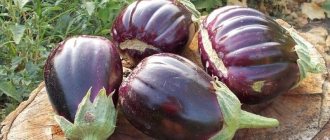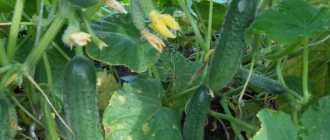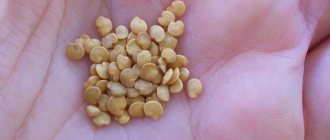Description
Eggplant Clorinda is a hybrid bred in 2006 by the Dutch . And already in 2007, the Russian State Register included the plant in the list of recommended ones for use.
Hybrid F1
On the packaging of Clorinda eggplants you can see the inscription F1, which means that this crop is a first-generation hybrid. In plant growing, a hybrid (from the Latin word hybrid - cross) is an organism that is formed by crossing different varieties.
Important! The parent plants must be of the same species, but as different as possible from each other; only under such conditions will a strong F1 hybrid be obtained.
When crossing several varieties, the first generation hybrids are most valued , since they receive the best qualities from their parents. But in the next generations, the weaknesses of the parents will most likely be in the lead, and sometimes a mutation may occur. For this reason, it is best not to collect seeds from plants produced from F1 hybrids.
What are the advantages of F1 hybrids and why are they so valued? Here are their main positive characteristics :
- have only positive qualities obtained from parent varieties;
- easily adapt to unfavorable conditions;
- may be superior to their parents (in such cases, hybrids will be called heterotic);
- high resistance to diseases and pests.
Despite all the advantages of the first generation offspring, some gardeners also highlight disadvantages :
- purchasing planting material only in stores, since it is impossible to obtain seeds from hybrid plants;
- the price is higher than regular seeds.
About other varieties of eggplant:
Yield and early ripening eggplant variety "Bourgeois"
Subtleties of caring for the “Black Opal” eggplant variety
Eggplant variety "Black Prince" and its cultivation
Distinctive features
Eggplant Clorinda is an early and productive species that has its own distinctive features:
- the pulp is whitish in color with a dense structure;
- has an excellent taste, does not taste bitter and does not oxidize for a long time;
- eggplant fruits are oval or pear-shaped, dark purple in color, medium size - from 12 to 20 cm.
Characteristics
Eggplant Clorinda has the following characteristics:
- the bush is straight and semi-spreading, approximately 70–80 cm high outdoors and 90 cm in a greenhouse;
- the stems, like all types of eggplants, are purple in color;
- medium-sized leaves with serrated edges;
- the weight of the fetus reaches approximately 0.3 kg, sometimes it can reach up to 1 kg;
- There are few seeds in the fruits.
Eggplant KLORINDA F1, description, growing experience.
Further care for eggplants Clorinda
The main thing when caring for eggplants transplanted to a permanent place is to follow the watering regime and apply fertilizing.
Since the height of the shoots of this vegetable crop can be 1 m, they must be tied to strong supports
so that the stems do not break under the weight of ripening fruits. Many vegetable growers recommend staking the Clorinda eggplant not to supports, but to trellises. Usually the central shoot is left on the bush, and it is recommended to remove the rest - in this case you can get a harvest of very large fruits weighing more than 1 kg.
Irrigation regime
Before the ovaries form on the bushes, water the eggplants weekly with warm water. After the fruits begin to ripen, the amount of watering is increased - eggplant plants are watered 2-3 times a week.
In greenhouses, after each watering it is necessary to ventilate so that the humidity in the room does not increase. You should also regularly loosen the root zone of the bushes and simultaneously remove all weeds.
Feeding eggplant bushes
Usually, for good yield, eggplants do not need enough fertilizers that are applied when planting seedlings in beds.
Therefore, it is recommended to fertilize Clorinda eggplant bushes once every 18-20 days.
A couple of weeks after transplanting the seedlings to a permanent place, they should be fed with urea or other fertilizer that contains nitrogen. From the beginning of budding, phosphorus and potassium should be present in the fertilizing composition. They activate root growth and improve the taste of ripening fruits.
Photo of the recommended feeding schedule for eggplants
You should also apply a solution of cow manure (1:10) or chicken manure (1:20) under the eggplant bushes.
, having previously infused it for 5-7 days in a warm place. You can also use greenfinch as a top dressing.
The application of organic matter is usually alternated with mineral fertilizing. And on a cloudy day, you can foliar fertilize eggplants, but the concentration of such fertilizer should be 5 times less, otherwise you can burn the foliage.
Feeding eggplant seedlings:
Stages of feeding eggplant in open ground and greenhouse
How to grow this variety yourself
Growing the Clorinda eggplant occurs in several stages : obtaining seedlings, transplanting and further care.
Growing seedlings
To get healthy, strong seedlings , follow the sequence of these actions:
- Preparation. Before planting, you must carefully examine the seed package. There are processed and unprocessed Clorinda seeds; this information should be on the packaging. If the seed is not processed, you will have to carry out the procedure yourself. Seeds are disinfected in a 1% solution of potassium permanganate for 20 minutes and immediately before planting, they are soaked in one of the growth stimulants. For example, “Epin” is suitable.
- Landing. The seeds are planted in a separate container to a depth of 2-3 cm, then the soil is watered and covered with film or glass.
- Care. Until the seeds have sprouted, maintain a temperature of +25...+28 °C and moisten the soil as it dries. 2-3 days after the first shoots appear (about 10–14 days), the temperature is lowered to +24...+25 °C during the day and +14...+15 °C at night. In order for a good harvest to grow, the daylight hours for Clorinda eggplants should be 12–14 hours. Watering - with warm water, at the root. Feeding - with complex fertilizers every two weeks.
Attention! Clorinda eggplant seeds are planted in the first or second ten days of February immediately in separate containers, since they do not tolerate picking. Peat or plastic cups work well.
As soon as the plants have 8-9 true leaves , they can be planted in the ground. This usually happens in mid-May.
Transfer
For a good harvest, the soil in which eggplants will grow must be prepared : dug up and fertilized. This can be done this way: water the soil with a solution of copper sulfate (5 g per 10 liters of water), this will get rid of parasites, and then fertilize.
Not every soil is suitable for planting the Clorinda variety. For example, you cannot plant eggplants after potatoes, peppers, tomatoes ; it is not recommended to grow them in the same place for several years in a row. The best predecessors for the crop are carrots, onions, cabbage, and legumes. The transplant is carried out before budding: it will be more difficult for the plant to get used to new conditions if it already has ovaries.
The process of planting seedlings consists of several stages:
- Make holes 20 cm deep, the distance between them is approximately 30 cm. 1 liter of a weak solution of potassium permanganate is poured into each hole.
- Carefully remove the plant along with the soil from the container and lower it into the hole (if the bush is in a peat pot, there is no need to remove it).
- Water the hole with the plant generously and sprinkle with loose soil. After planting, the eggplants are sprinkled with dry soil or humus and allowed to “rest” for 20 days. During this time, the bush will need only moderate watering.
Further care
During the growing process, it is recommended to form a bush . The procedure is not mandatory, but if you want to have strong and compact plants in the garden, you cannot do without it.
When the height of the plant reaches 30 cm, it is pinched. As a rule, only 4–6 of the rapidly growing shoots are saved, and the rest are removed, as are yellowed leaves.
Water the plants with warm water at the root once every 10–12 days , and if the weather is dry, then once every 7 days. After moistening, it is advisable to loosen the soil around the bushes.
Features of cultivation and possible difficulties
If you do not know the intricacies of growing “Clorinda”, or violate the agricultural practices of the variety, troubles will inevitably appear in the form of diseases or reduced yields.
What you should pay attention to:
- The variety grows well in any soil - open and closed; it can be planted in a greenhouse 2-3 weeks earlier. In a greenhouse, you can do without growing seedlings by sowing seeds directly into the beds.
- When growing Clorinda, it is important to prevent excessive soil moisture, and when growing under cover, it is necessary to control the moisture content not only in the soil, but also in the air. With excessive moisture, the variety is prone to fungal infection.
- The variety needs regular feeding. With a lack of nutrition, the fruits become smaller and the number of ovaries is reduced. It is necessary to feed the plant at least 5 times after planting in the ground.
The gardener will tell you about his experience of growing Clorinda in the following video:
Harvesting and application
Three months after sowing the seeds, the first harvest can be harvested . As soon as the eggplants are ripe, they must be cut off immediately, otherwise the number of ovaries may decrease.
Help: Eggplant pulp contains many useful substances: potassium, copper, iron salts. It is thanks to these elements that fruits improve the functioning of blood vessels, heart, kidneys and liver, and reduce cholesterol levels.
Clorinda eggplants can be stored for up to two months at a temperature of 6-7 °C .
Vegetables are fried, baked, pickled, dried or frozen for longer storage.
How to care for seedlings
Judging by reviews from gardeners, the Clorinda F1 eggplant seeds germinate vigorously and vigorously. After the sprouts appear, the film is removed, and the air temperature is reduced to +17 degrees, moving the boxes with seedlings to a cooler place. After a week, it is necessary to increase the temperature again to +25 during the day and to +14 at night. If the air is colder, the plants may die. The boxes with seedlings are periodically turned so that they are illuminated by the sun from all sides. If there is a lack of light, the sprouts need to be illuminated with lamps for at least 12 hours a day. When the seedlings grow up and become stronger, they begin to be gradually hardened off, periodically taking them out into the open air.
Advantages and disadvantages
The hybrid eggplant Clorinda has its advantages and disadvantages.
| Advantages | Flaws |
| Good and tasty harvest | The seeds are not suitable for further planting |
| Resistance to weather conditions, diseases and pests | Dear seeds |
| Few seeds | |
| Grow both in greenhouses and in open ground |
Clorinda has more advantages than disadvantages , which explains the popularity of the hybrid.
Characteristics of the variety
In comparison with already known eggplant varieties, the Clorinda hybrid has a number of advantages:
- versatility - can be grown both in a greenhouse and in the garden;
- good yield indicators (commercial product yield in open ground is up to 2.8 kg/m2 or 220 kg per one hundred square meters, in a greenhouse - up to 320 kg per hundred square meters);
- cold resistance, including the ability to set fruit when weather conditions worsen;
- long fruiting period;
- high resistance to tobacco mosaic virus.
Eggplant Clorinda is characterized by high yield and long fruiting period
Reviews
Most often, gardeners leave positive reviews about Clorinda eggplants , noting 100% seed germination and ease of growing.
Tamara Pavlovna, Magnitogorsk : “The eggplant Clorinda is very tasty. I planted this hybrid for the first time and did not regret it. It is resistant to weather conditions and does not require any special skills to grow. I store eggplants in a drawer with parchment between them, so they stay fresh longer.”
Irina Olegovna, Krasnodar : “Recently I was diagnosed with kidney problems, in addition to medications, the doctor advised me to include eggplants in my diet. I chose the hybrid Clorinda. To be honest, I didn’t expect that eggplants could be so tasty. The pulp is quite dense, but what pleased me most was the absence of seeds. Despite all the difficulties that may arise during planting and soil preparation, it is worth it!”
Fruit properties and yield
Eggplants ripen in early August.
- Oval fruits of medium size, weighing up to 350 g.
- Smooth skin of bright purple-black color, glossy.
- The white flesh is dense with an excellent taste and smell of mushrooms; It’s not bitter, there aren’t many seeds.
Eggplants ripen gradually.
From 1 m2, caring gardeners harvest up to 6 kg of wonderful vegetables. The fact that the fruits are ripe is indicated by elastic flesh and dark skin color. The “blue” ones are cut off with the stalk.
Vegetables should not be allowed to overgrow, as the pulp and seeds inside will become coarse and the taste will become bitter.
Clorinda is used for preparing side dishes, snacks, and winter preparations.
Planting seedlings in open ground
Planting in open ground is carried out after the seedlings have grown and the weather is warm outside. Seedlings are planted around mid-May. The soil is prepared in the fall, after harvesting. The soil is dug up and all weeds are removed. Then add manure and mix.
The process of planting eggplant seedlings:
- make beds;
- dig holes 30-40 cm deep;
- the distance between each hole is left 50-65 cm;
- Place the seedling in the hole and bury it with soil, lightly compact the soil near the stem.
At the end of planting, water the beds with warm water. For the first few weeks, the beds should be covered with a warm cloth at night. In May there are often cold snaps at night, and heat-loving eggplants can freeze.
Review: Seminis Clorinda F1 eggplant seeds - Exactly, a super productive hybrid!
Hybrid Clorinda F1 - the first eggplants grown with my own hands in the first year of my passion for gardening. At that time, I didn’t understand much, reading the description of the variety on the packaging, I didn’t know the meaning of some terms, I chose plants more based on the picture on the bag of seeds, and I did a little reading on the description.
And I was just lucky that the choice fell on this hybrid. In February, before sowing, I soaked the seeds in the growth stimulator Epine, which promotes their rapid germination. Covered it with two layers of gauze and left it in a warm place for about five hours. Then, having calcined the soil mixture, I made funnels, compacted them a little and put the seeds there. She spilled it with warm water, poured it on top, again slightly compacted the surface and moistened it. I covered it with film to create a microclimate, wrapped it up and put it in a warm place... Many often complain that the seeds do not germinate or take a long time to germinate. My eggplants appeared within a week. It's a pity that I didn't take a photo then. Then there was the picking of seedlings... Of course, eggplants do not tolerate this process well, just like peppers. But after two weeks of living in the greenhouse, they began to grow stronger and grow. And then I put them in the garden under the Snowdrop greenhouse. And then the bushes surprised me! Firstly, they were tall and powerful, and secondly, they had good foliage, which meant they protected the fruits from the scorching sun. And thirdly, I noticed that if a Colorado potato beetle entered the greenhouse and bit a leaf (I did not use poison), then the leaf would soon grow back. That’s when I understood the meaning of the words “quickly regenerates” in the description of the hybrid on the website. By the way, to protect the young plant from colorados, I used polyethylene cylinders, which were obtained by trimming transparent plastic bottles. These cylinders were “dressed” on the planted plant and saved the young plants until they got stronger. And now about the harvest. The fruits set quickly and abundantly... They looked very attractive, with dense, non-watery pulp. The weight of the fruit is quite impressive, 600-800 grams. Well, the taste... yes. There are almost no seeds. The taste of the baked vegetable had the consistency and flavor of butter. Well, I had such an association. Although, definitely, in order to reap the harvest, you will have to plow. During the growing process I will give photos. And now, if you want, a recipe for a very tasty eggplant snack with a spicy-sweet taste, which is done within 15-20 minutes! I'm giving you the recipe! You will need: 2 kg blue eggplants 2 pcs. sweet bell pepper 1 bitter pepper (you can have more or less, to taste) 1 head of garlic, parsley. Cut the eggplants into large pieces, boil in salted water for 3-4 minutes so that the pieces do not become deformed. Drain the water, let it drain and lightly press down with a weight to get rid of excess water. Pass the peppers and garlic through a meat grinder. In a separate bowl, mix the filling: 1.5 tbsp. tablespoons salt 1.5 tablespoons sugar 130 ml 9% vinegar 1 cup vegetable oil. Mix lightly squeezed eggplants with the filling. Sprinkle generously with chopped parsley. Mix carefully. Let it sit for a bit. Ready! You can put it in jars, put it in the refrigerator... and enjoy it for several days in a row. It looks beautiful with red, orange and green peppers. Enjoy!
Growing seedlings
Growing eggplant seedlings is a critical stage on which the future yield of the bushes depends.
Timing
Eggplant seeds are planted closer to spring. Optimal time for planting: late February - early March. The main thing is that by May the seedlings have already grown enough to be transplanted into open ground.
Soil preparation
For sowing, you can purchase a ready-made soil mixture for vegetable crops. Or you can prepare the soil yourself. For the base, take regular soil from the site:
- The earth is calcined and watered with a weak solution of potassium permanganate.
- Add wood ash and coarse river sand.
- To stir thoroughly.
You can add coconut fiber if you have it. Or add a small amount of peat. Drainage (fine gravel, pebbles or crushed eggshells) is poured into the bottom of the container.
Seed sowing scheme
Make grooves in the soil 1 cm deep. Fill in the seeds and lightly sprinkle them with soil. It is not recommended to plant seeds too close; it is advisable to leave a little space between them.
Subtleties of care
We recommend reading our other articles
- Potato variety Adretta
- White broad-breasted turkeys
- Recipes for lecho with carrots
- Grafting by copulation
Clorinda F1 eggplants require regular care.
- Watering can be done in the early morning, until the sun has fully risen, or in the evening, after it has set below the horizon. For irrigation use warm, settled water.
- Every week, after watering, when the water is absorbed into the ground, it is necessary to loosen the rows and under the bushes. Do this carefully so as not to damage the root system. But in this case, hilling is not necessary.
Interesting! Short daylight hours help to increase yields and ripen fruits 2 weeks ahead of schedule. It’s easy to shorten the daylight hours for this plant; you just need to darken it with dark material from 6 pm to 8 am.
- Eggplants grow only with sufficient fertilizing, so it is necessary to fertilize the plantings once every 2 weeks. Complex mineral fertilizers diluted with water are used. For 10 liters of water, 30 grams of the drug is usually required, although depending on the type of fertilizer and brand, the proportions may vary, so you should carefully study the instructions.
- The first bud that appears on a plant is always plucked off. And after 6 ovaries appear, the growth point is pinched.
- Those plants that produce the most harvest should be tied up so that they do not break under the weight of the fruit.
Ripe fruits must be cut and used for food on time. Hybrid eggplant Clorinda F1 can be boiled, fried, stewed, baked. If the harvest is plentiful, you can store the fruits in the refrigerator for at least a week, or dry them, freeze them, or prepare them for winter preservation.
To grow Clorinda F1, you can use a trellis or simply tie it up











